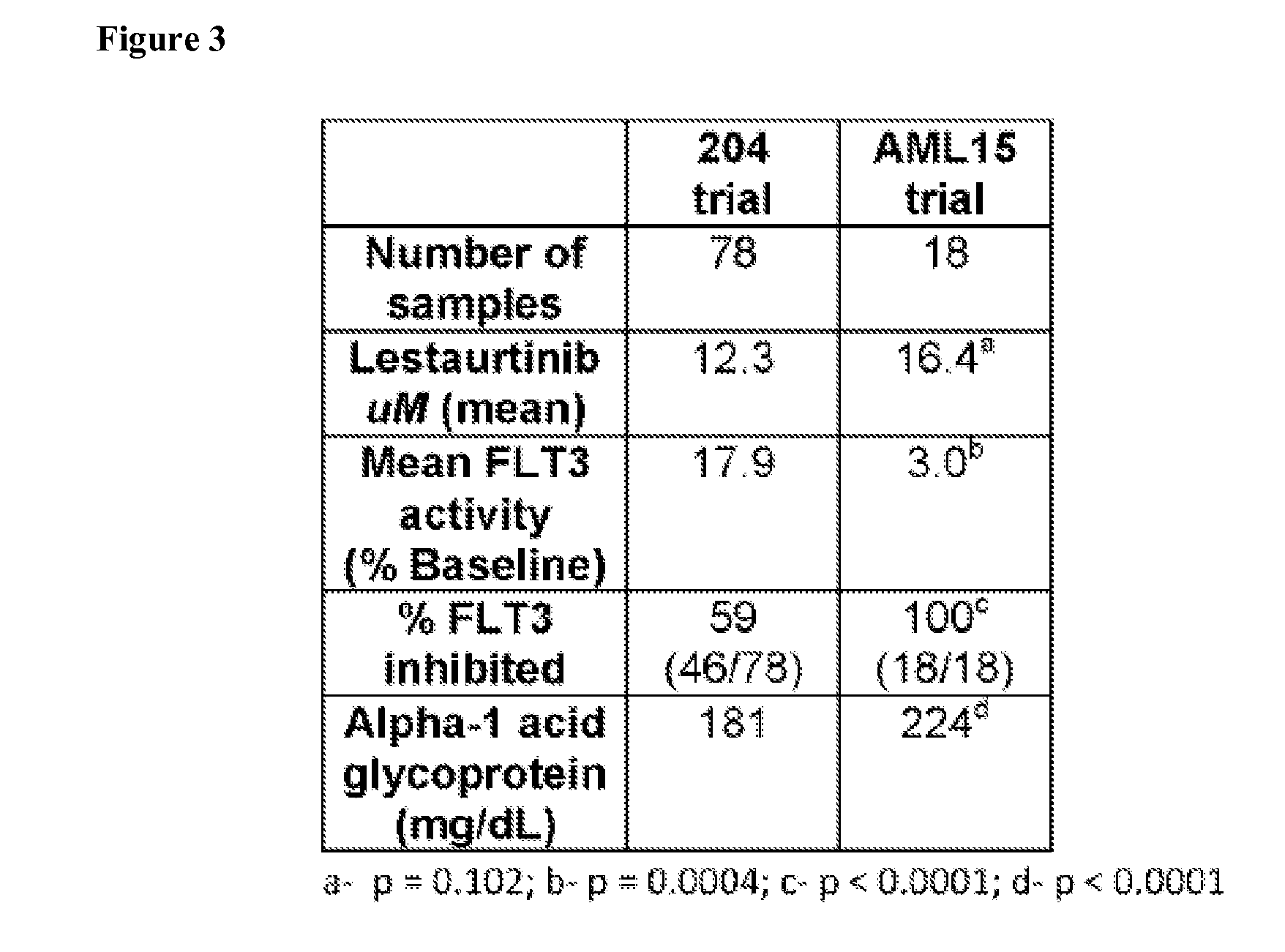Neutralization of flt3 ligand as a leukemia therapy
a technology of flt3 and leukemia, which is applied in the field of neutralization of flt3 ligand as a leukemia therapy, can solve the problems of modest success and exceptionally poor prognosis of leukemia patients harboring activating flt3 mutations, and achieve the effects of inhibiting the binding of flt3l, preventing a leukemia relapse, and inhibiting the activity of tyrosine kin
- Summary
- Abstract
- Description
- Claims
- Application Information
AI Technical Summary
Benefits of technology
Problems solved by technology
Method used
Image
Examples
example 1
FLT3 Inhibition is More Effective in Newly Diagnosed Patients than Relapsed Patients
[0120]Using a plasma inhibitory activity (PIA) assay for FLT3, in vivo FLT3 inhibition in AML patients treated with chemotherapy followed by lestaurtinib was examined, comparing newly-diagnosed AML patients (enrolled on the MRC AML15 trial) with relapsed patients enrolled in the Cephalon 204 trial. Both groups of patients had been treated with a 3 drug regimen followed by 80 mg twice daily of lestaurtinib. Plasma samples collected at trough time points on Day 15 following the beginning of chemotherapy were used to measure both PIA data and lestaurtinib drug levels (78 from the 204 trial, 18 from the AMLI5 trial). FLT3 inhibition by lestaurtinib was distinctly less effective in the relapsed patients (204 trial) compared with the newly-diagnosed patients (AML15 trial). Preliminary data from both trials indicated that FLT3 inhibition to a level of less than 15% of baseline at the day 15 time point was s...
example 2
Plasma FLT3 Ligand Levels are Elevated Following Chemotherapy
[0121]FL levels were examined in the plasma samples obtained during the clinical trials described above. To derive an estimate of FL levels in newly diagnosed AML patients, plasma from 7 AML patients was obtained at diagnosis. The FL levels for these 7 patients ranged from 2 to 6 pg / mL (mean 3 pg / mL). For AML patients at first relapse, 72 baseline plasma samples from the Cephalon 204 trial were tested. In these patients there was considerably more variation in FL levels, ranging from 2 pg / mL to as high as 2953 pg / mL (mean 57 pg / mL). Shown in FIG. 4A are the individual and mean FL levels for Day 15 of course 1 of induction therapy for the newly diagnosed AML15 patients compared with Day 15 of salvage chemotherapy for the relapsed Cephalon 204 trial patients. While there is wide individual variation in FL levels in both trials, as a group, the relapsed patients have significantly higher levels. Plasma samples available from ...
example 3
Increased FL Levels are Associated with Decreased FLT3 Inhibition
[0127]Because FL levels continue to rise with successive courses of chemotherapy, it was investigated whether in vivo FLT3 inhibition by lestaurtinib would be less effective after the first chemotherapy course. The mean PIA value from course 1 of the AML15 trial (18 samples total analyzed) was 3% of baseline, while in courses 2 through 4 (18 samples total) the value was 6.8% (p=0.04). In order to better establish an association between elevated FL levels and impairment of FLT3 inhibition, the data set for cases in which individual patients had similar plasma concentrations of lestaurtinib at two different time points during treatment, but different levels of FL were examined. Shown in FIG. 9A are two such cases. In both examples, the FL concentration was above 3 ng / mL, and in both cases the intensity of FLT3 autophosphorylation was more than 2-fold higher.
[0128]In order to better characterize the effects of chemotherap...
PUM
| Property | Measurement | Unit |
|---|---|---|
| concentrations | aaaaa | aaaaa |
| concentrations | aaaaa | aaaaa |
| concentrations | aaaaa | aaaaa |
Abstract
Description
Claims
Application Information
 Login to View More
Login to View More - R&D
- Intellectual Property
- Life Sciences
- Materials
- Tech Scout
- Unparalleled Data Quality
- Higher Quality Content
- 60% Fewer Hallucinations
Browse by: Latest US Patents, China's latest patents, Technical Efficacy Thesaurus, Application Domain, Technology Topic, Popular Technical Reports.
© 2025 PatSnap. All rights reserved.Legal|Privacy policy|Modern Slavery Act Transparency Statement|Sitemap|About US| Contact US: help@patsnap.com



